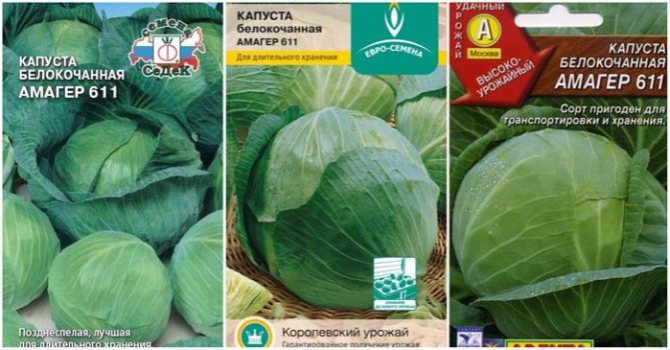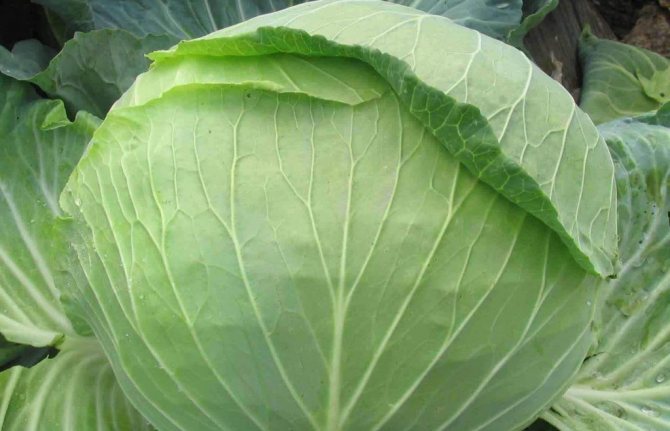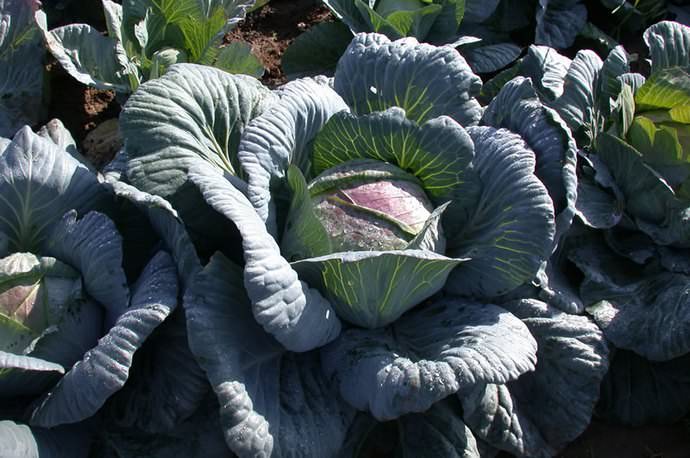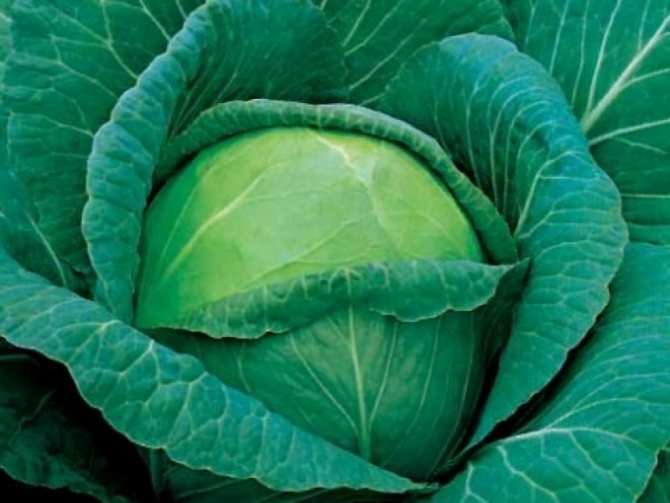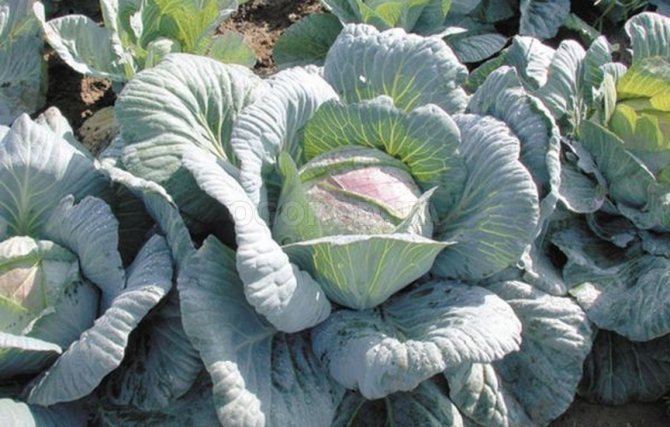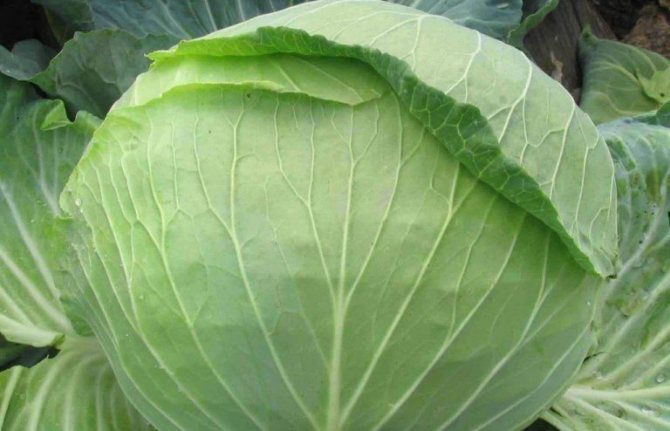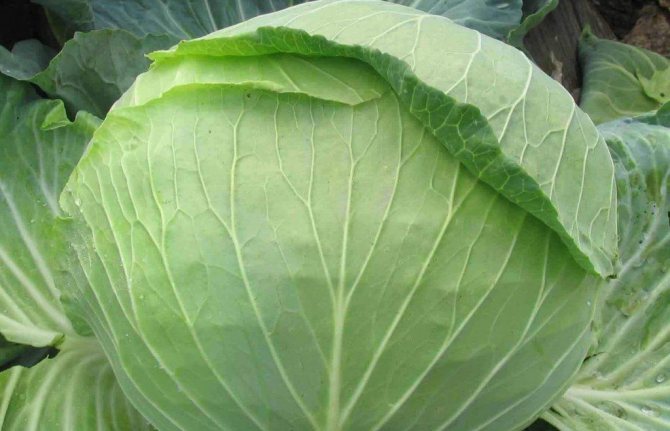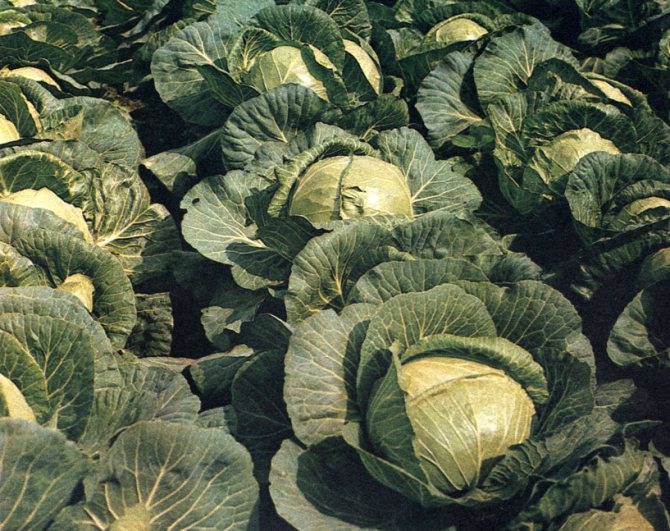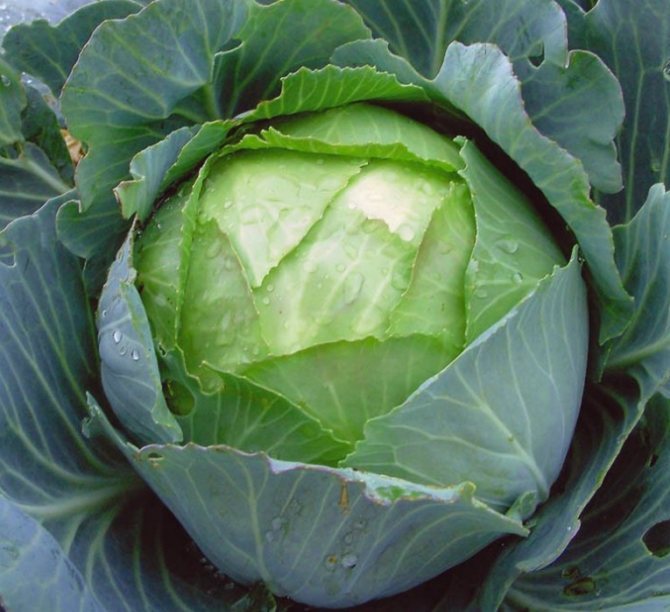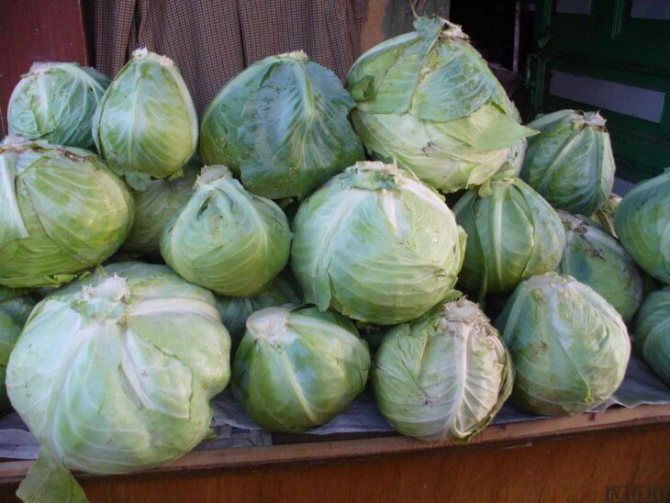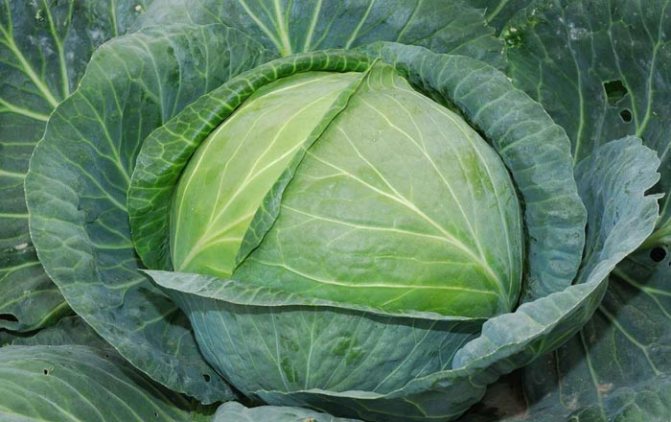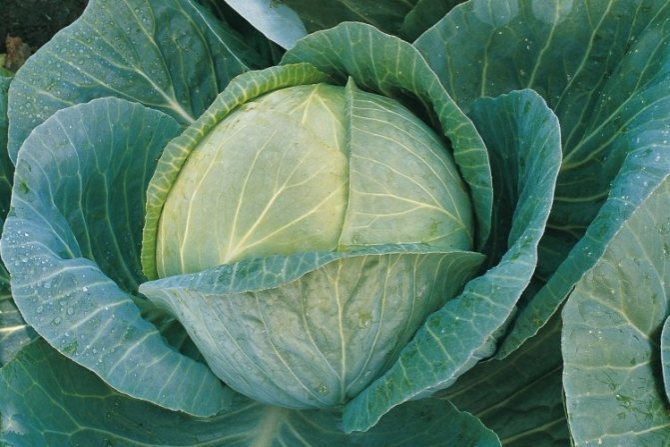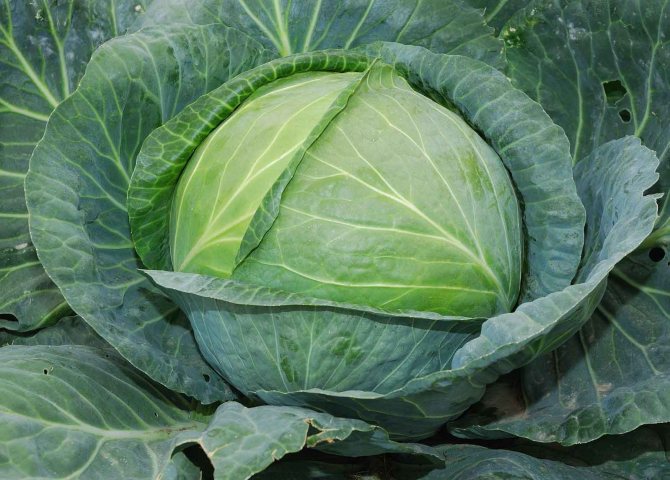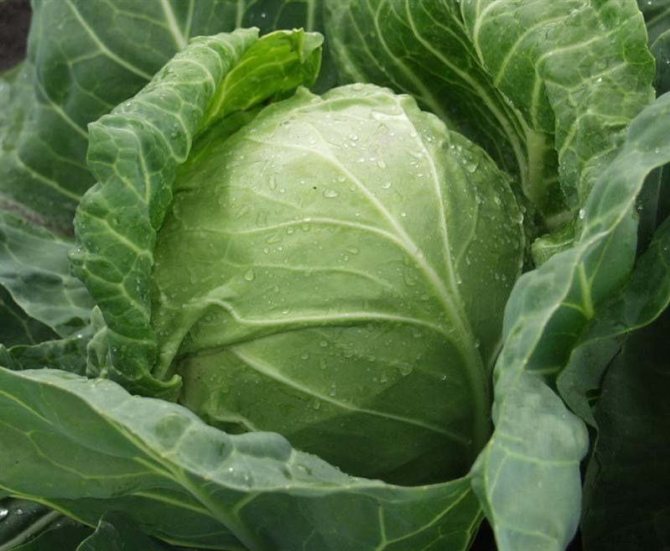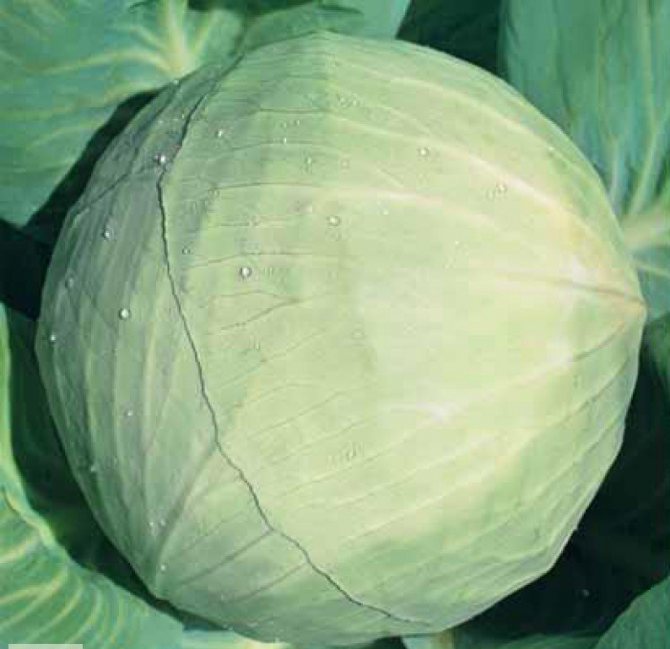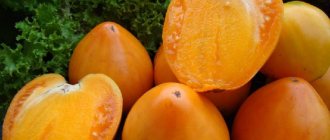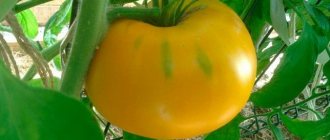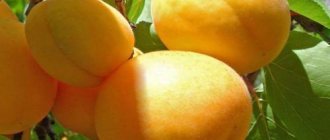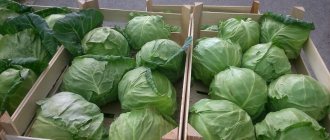Vegetable growing »Cabbage
0
755
Article rating
One of the oldest but still popular varieties is the Amager cabbage. Breeders bred Amager 611 cabbage back in the 20s of the last century. The qualities of this variety allow you to get high yields even from a small area.

Characteristics of Amager cabbage
Amager or Amager 611?
Often, novice gardeners have a question, what is the name of the cabbage: Amager or Amager 611? I must say that both names are correct. Initially, VNIISSOK developed a variety whose name included numbers. It was intended for planting in all regions of our vast Motherland, with the exception of the most northern corners, where the late garden culture does not have time to ripen.
But after a certain period of time, small varietal changes occurred. Amager 611 cabbage seeds, which were harvested in the southern regions of the country, have become more resistant to higher daytime temperatures. The culture has developed little resistance to the effects of drought. At the same time, all the main varietal characteristics have been preserved in full. This "sub-grade", so to speak, began to be named without numbers.
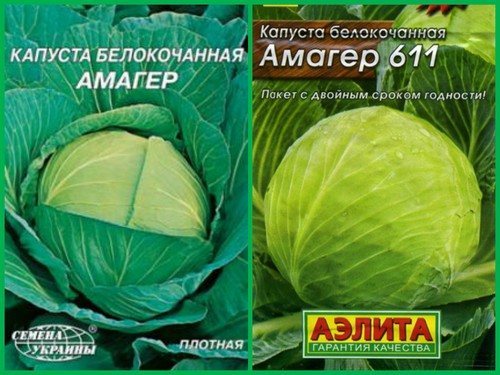

Now in the territory of the Russian Federation, most often, if not everywhere, there are bags with Amager 611 seeds. In Moldova, Kazakhstan, Ukraine and other former Soviet republics, in most cases Amager cabbage seeds are on the shelves of agricultural stores.
Harvesting
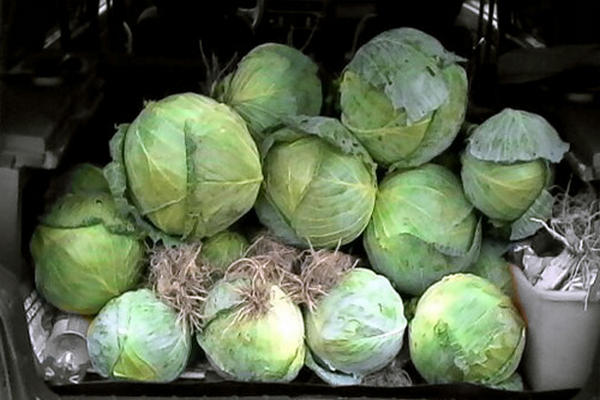

As a late-ripening variety, Amager heads of cabbage are ready for harvesting no earlier than the end of September. Gardeners of the Northwest often leave cabbage to ripen until early October. Adult plants are not afraid of small frosts, the first snowball.
Cut the cabbage on a dry day, always leaving a long stump. Placed for storage in a dry basement, cellar. The upper integumentary leaves on the forks are partially removed by placing the cabbage on racks or hanging it from a stump.
With the correct mode of humidity and air temperature, the variety lies until mid-spring. This is especially convenient for those who prefer to ferment cabbage not immediately in the fall, but gradually, during the winter.
Harvesting and storage
The crop is harvested depending on ripening. Usually this is the end of September - October. Heads of cabbage are cut with a knife, leaving a long stump. The collection is best done in dry weather.
Each head of cabbage must be inspected before storing it. The denser ones will last longer. It is recommended to cut off excess leaves, dry for several hours in the open air.


Harvesting of the Amager variety is carried out at the end of September-October
With high humidity and sharp temperature fluctuations in the storage, favorable conditions are created for the development of gray rot. First of all, it affects deformed or slightly frozen cabbage. The affected heads of cabbage are isolated, and the storage sites are treated with antifungal drugs.
Growing Amager cabbage, subject to certain rules, does not present any particular difficulties. The result of constant watering, timely feeding and disease prevention will be a generous harvest that will be stored throughout the winter. Having advantages over other types of cabbage, it is very popular among gardeners.
Cabbage seeds Compass F1. 1000 seeds. Takii seeds.Mid-season white-headed hybrid for fresh consumption, processing and storage. White cabbage hybrid. Ripening period: 75 - 80 days from transplanting seedlings into the soil. The plant is strong, with high endurance. Heads of cabbage are round in shape, beautiful bluish - green color. The forks are dense, weighing 3.0 - 4.0 kg., With a good internal structure. The stump is small. The cabbage tastes great. The hybrid preserves the crop for a long time without losing qualities in the field after ripening. It stands out for its good transportability of heads of cabbage over long distances. Stored in storage for 3-4 months. Cabbage hybrid shows resistance to: FY (FOC) race 1 / Downy mildew (Fusarium, Fusarium wilting, Jaundice) /; internal leaf necrosis.
Our products are: - professional vegetable seeds; - flower seeds; - seedlings of berry plants; - lawn grass seeds; - sprayers; - means for drainage of cesspools; - tape for drip irrigation; - soil / for the Crimean people /. The main specialization of our company is the sale of vegetable seeds in professional packaging. We represent almost all world and Russian brands. The company is ready to cooperate with both retail and large wholesale buyers. The geography of this cooperation: all of Russia. To achieve this coverage, we have signed client agreements with all major transport companies. We also deliver goods by Russian Post (to the countryside) or by EMC - air mail of the Russian Post (over long distances and especially live planting material). In any case, we adhere to the principle: distance is not a reason to deny yourself quality! Order goods in Crimea - get them at your place of residence!
Description
The description of Amager cabbage must begin with an indication that it is a late-ripening variety. Forks should be harvested 150-175 days after the emergence of mass crop shoots. The rosette is formed of a semi-spreading type. The leaves are wide, semi-concave, well raised from the ground. The edges of the leaf plate are rounded with barely noticeable denticles, more reminiscent of a wavy line. The color of the leaf is gray-green with a pronounced waxy bloom. There is no wrinkling.
The head of cabbage is formed of impressive size, on average 2400-4000 g. The outer stump is of medium length, the inner one is small. The fork is formed by a very dense round-flat, occasionally round-concave or round. Cabbage has a high yield - up to 6 kg / sq. meter. Suitable for industrial cultivation. In this case, the yield reaches 65 tons / ha. Plants develop evenly, so mechanized harvesting is possible. It tolerates transportation well.
Pros and cons
Like any variety, Amager cabbage also has its advantages and disadvantages... Of the big advantages are:
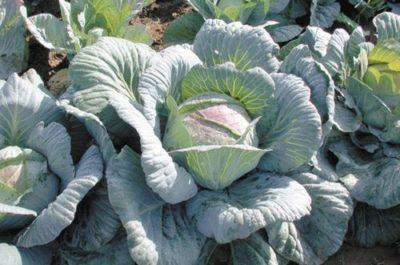

The main advantage of this cabbage variety is that it has a very excellent keeping quality, its forks are reliably stored all winter and spring.- Amager calmly survives late frosts (seedlings are not damaged) up to 5 degrees below zero.
- This variety is not susceptible to cracking even during prolonged rains.
- A consistently high yield is guaranteed.
- The forks ripen evenly, which makes them easy to remove with a technique.
- Does not deform during long-term transportation.
IMPORTANT: The main disadvantages of Amager cabbage: it is prone to black rot disease, does not withstand a long time without watering and does not tolerate hot weather (stops growing).
What features can be distinguished
The main advantage of Amager is its very high keeping quality. Cabbage forks can be stored all winter and spring.
The variety has high resistance to cold and cracking. Seedlings planted in the ground are not damaged by late frosts, and not yet harvested forks are able to withstand -3 ° C.
Of the minuses, one can single out the susceptibility to the disease of fusarium or black rot.The defeat of a plant disease is more often observed with improper agricultural technology. Amager 611 does not tolerate extreme heat and prolonged absence of watering. Under these circumstances, the plant stops growing.
Features of the
When composing a description of the Amager cabbage variety, mention should be made of its features. Of the advantages, of course, it is necessary to highlight the increased keeping quality. The fruits can be stored until April. At the same time, the taste will only improve. If, when harvesting, the assessment of taste is only 3.5 points, then after 2-3 months of storage it rises to 4.5 points.
The resistance to cracking and frost resistance should also be emphasized. Planting seeds and seedlings in the ground is possible even on the eve of late spring frosts. Forks ripening on the ridges can tolerate up to minus three degrees Celsius.
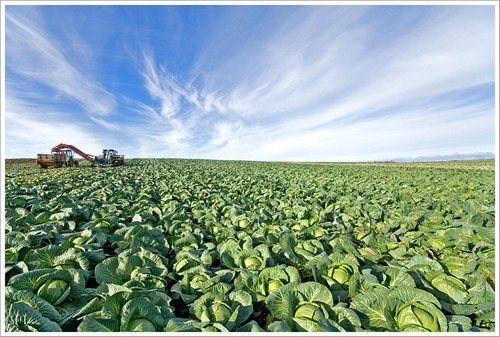

The disadvantages of the variety are susceptibility to certain cabbage diseases. In particular, with inept agricultural technology, there is a risk that the forks will pick up black rot (fusarium) or vascular bacteriosis. Punct necrosis is also possible during storage.
Also, in the description of Amager 611 cabbage, it should be emphasized that there is such a drawback as the inability to withstand extremely high temperatures. With their prolonged exposure, the forks stops growing and needs abundant watering.
Variety characteristic
From the moment of seed germination to harvesting, it takes about 145-155 days, so the variety is considered to be late-ripening. In hot summer, these terms are shifted.
Cabbage variety Amager 611 is harvested: up to 7 kg of high-quality heads of cabbage are harvested from 1 m². Its only drawback is its low resistance to some diseases.
Description of the head of cabbage
In the description of Amager cabbage, the high quality of the heads is noted. The variety has excellent keeping quality and is stored in the basement until late spring. If the room is damp and poorly ventilated, the heads of cabbage can rot. The top leaves and cut are affected first.
Immediately after harvesting, the leaves of the heads of cabbage have a characteristic bitterness, which disappears after 2-3 months of storage. They also become more juicy.
Forks are stored on wooden or plastic pallets, turned upside down. Heads of cabbage are laid in one layer, leaving a small distance between them. Check the condition of the vegetables periodically and remove rotten or moldy leaves.
Application of the vegetable
The variety is suitable for preparing first and second courses, as well as preservation. Cabbage should not be salted and fermented, because its leaves are too tough, and this affects the taste of the finished product.
To prepare fresh salads, the vegetable is finely chopped, salted and intensively crumpled. The finished dish is seasoned with butter, mayonnaise or sour cream.
Pests and diseases
The cultivation of this variety is difficult due to its tendency to cruciferous diseases. Everyone who planted Amager notes that most often the plant suffers from:
- Peronosporosis (leaf spot). The causative agent is a fungus. The disease manifests itself even at the seedling stage. Affected leaves dry quickly and fall off
- Powdery mildew (gray spots on heads of cabbage). It spreads quickly throughout the plant and makes the forks unusable for long periods of time.
- Fusarium (the appearance of yellow veins on the leaves). Infected plants form loose small forks or stop growing altogether. The disease enters the soil through the affected seeds.
The main pests of this vegetable are cruciferous fleas, slugs and grape snails. They feed on the succulent greens of the plant and thereby damage the head of cabbage.
Agrotechnics
This cabbage is planted on seedlings at the end of February-March. Seeds can be sown in open ground already from the first days of April (in the southern regions) and in the last days of April (in central Russia). In more northern regions, they are planted only in seedlings.Seedlings are ready for planting 40 days after germination.
This cabbage should be planted at a distance of 60-70 cm from each other. The seeding depth is 1.5-2 cm. When planting fresh (!) Seedlings, the cabbage stem can be immersed until the beginning of the leaf plates.
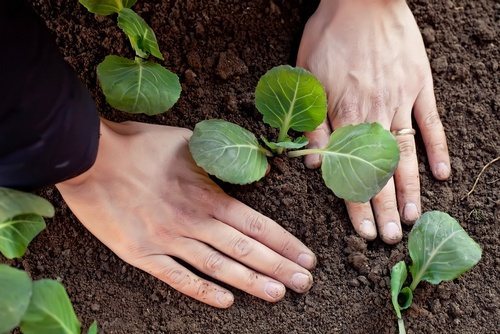

This variety is hygrophilous. Therefore, watering should be carried out at least 2 times a week. If the root area is mulched, it can be watered once a week. Due to the highly raised leaves, it needs hilling. It responds well to this technique of agricultural technology and forms a powerful root system. Cabbage is favorably influenced by feeding. They should be carried out at least 2-3 times a month.
Growing conditions
Since Amager cabbage belongs to late-ripening varieties, it can be grown both as sowing for seedlings and directly on a permanent place in the garden. In the northern regions, due to the short summer, the first cultivation method is preferable. Due to the susceptibility of this variety to various diseases, the seeds require disinfection before planting.
When thinking about when to plant Amager cabbage for seedlings, you need to proceed from the climatic characteristics of your region. It is necessary to take into account the timing of the possible harvesting on the one hand, and the estimated dates for planting seedlings in the ground on the other. Usually late varieties of cabbage are sown during April. On a permanent place, the Amager variety in the middle lane can be sown in early May, using additional film shelters on arcs.
At a temperature of about 20 ° C, cabbage shoots appear in 2-5 days.
If this is not done, then the seedlings will stretch out and subsequently die. The best place for the growth of cabbage seedlings is a greenhouse or greenhouse, where the necessary conditions can be maintained without difficulty. Two weeks after the emergence of seedlings, the seedlings are planted in separate containers, while deepening it in cotyledon leaves. After picking, it is advisable to spill Amager cabbage again with a solution of phytosporin.
You can plant cabbage seedlings in a permanent place of growth in open ground in the second half of May. During planting, at least 50-60 cm is left between the plants, while the row spacing should be about 60-70 cm.Immediately after planting, all the land around the bushes is sprinkled with a mixture of tobacco dust and wood ash. This will help scare off pests and serve as additional feeding.
In the future, caring for cabbage consists of weeding, loosening the soil, dressing and watering. Abundant watering is necessary for Amager cabbage in July - August during the formation of heads of cabbage. A month before harvesting, watering should be reduced to a minimum. Due to the susceptibility of this cabbage variety to diseases, it is advisable to carry out several more treatments with phytosporin during the summer.
As mentioned earlier, Amager 611 is grown universally in two ways:
- Sowing seeds in the ground.
- Sowing seeds for seedlings.
Seeds are planted in a direct way at the end of April, while in regions with a cold climate, it is advisable to grow cabbage only by seedling. Sowing agrotechnology is as follows. Sow cabbage seeds on
seedlings
in late March - early April, while the grown seedlings are transplanted into open ground from the end of April. Growing times differ in different regions.
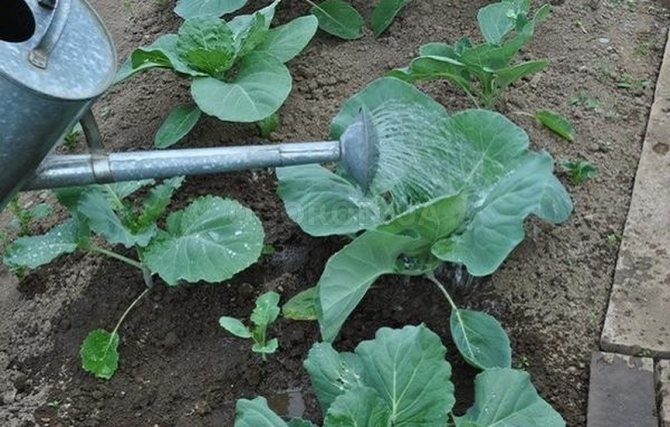

Amager can be grown by seeds or seedlings. But since in many regions there is a short summer, it is recommended to plant a crop using seedlings.
We suggest that you familiarize yourself with: Is it possible to freeze beets for the winter: how to properly freeze fresh beets at home, recipes
Planting seedlings
Seedlings can be planted from mid-February to early March. To avoid various crop diseases in the future, seeds are treated with a weak solution of potassium permanganate. They are placed in the composition for 30 minutes. You can use Fitosporin, in which the seeds are soaked for 10 hours. Then the grains are dried and planted in containers with soil.
As soon as sprouts appear, the coverings from the containers are removed and placed in a sunny place. Two weeks after the emergence of shoots, a pick is carried out, seating each plant in a hotel container. After transplanting, it is recommended to water the seedlings with Fitosporin again.
Sowing is carried out in early April to a depth of 2 cm. Cover with foil to create a greenhouse effect. At a temperature of about 20 degrees and good lighting, seedlings will appear on the 4th - 5th day.
After that, the seedlings must be transferred to a cooler place. If this is not done, the sprouts will begin to stretch, weaken and may die. After 12-15 days, the seedlings are dived into separate containers. Watered once a day with warm water in the morning.
In the phase of the third true leaf, the first feeding is carried out, the second - when the fourth leaf appears.
Landing
The seeds can be planted on seedlings or directly into the ground. The seedling method is suitable in cold regions.
Before sowing, they are hardened by keeping them in water at a temperature of 50 degrees for 30 minutes. Then transfer to cold for 2-3 minutes. Then it is etched with a fungicide.
They are sown in peat pots or tablets or in plastic cups of 1-3 grains. The soil should be saturated with organic matter. The weakest sprouts are discarded after germination. Until germination, they are kept in a warm place, then they provide a temperature of + 15-18. If it is higher, the bushes will stretch out, thin out and become weak.
They are transplanted to the garden bed after 50-55 days. At this time, if necessary, feed 1-2 times.
Growing seedlings
Sowing is carried out in early April to a depth of 2 cm. Cover with foil to create a greenhouse effect. At a temperature of about 20 degrees and good lighting, seedlings will appear on the 4th - 5th day.
After that, the seedlings must be transferred to a cooler place. If this is not done, the sprouts will begin to stretch, weaken and may die. After 12-15 days, the seedlings are dived into separate containers. Watered once a day with warm water in the morning.
In the phase of the third true leaf, the first feeding is carried out, the second - when the fourth leaf appears.
Testimonials
Reviews about Amager cabbage are very different. Someone complains that the variety is very prone to fusarium wilt. For some, it even begins literally immediately after the beginning of the formation of the head. Others report that diseases are nothing, but the bitterness in the leaves persists for the first 2 months and is felt very strongly. But both those and others confirm the high stable yield of Amager cabbage. However, judge for yourself whether this variety suits you or not.
Natalya, Odessa region The variety is not bad, I have been growing it for many years. Forms heads of cabbage together, 3-4 kg each. Sometimes 6-8 kg heads are found, but this is rare. Lies in the cellar until spring, then you need to peel off the upper leaves - it starts to rot.
Oleg, Voronezh region Amager cabbage was grown by my grandfather. The variety is excellent, I like it. True, sometimes the roots of purchased seedlings rot. Just drop it off, and after a couple of days it starts to rot. I stopped buying seedlings, my wife began to grow them herself, pre-processing the seeds, and they forgot about decay. For prophylaxis, I also treat the area for cabbage with Trichodermin. Pah-pah, but so far it helps.
Valery, Chelyabinsk region I am growing Amager 611 in a greenhouse. I have no complaints about the grade. It grows well, ties large forks, can be stored for a long time. Good cabbage!
Reviews of gardeners
- Oleg, 57 years old: “I have been growing cabbage for sale for 2 years. Among the late-ripening ones, I have the Amager variety. I want to say that you need to look after him thoroughly. Especially, in time to carry out the processing of plants from pests and diseases. More than once I have dug out bushes affected by black leg or powdery mildew. This year, in the spring, I carried out a prophylactic treatment, I also monitor the moisture content of the soil, I laid a mulch layer of sawdust. "
- Marina, 38 years old: “The Amager variety is unique for me in that it is not picky about the type of soil.But you can't grow it in one place every year. Dolomite flour will allow me to fight pests. I just scatter it over the ground. I use the seedling method for growing, because then the plants are more hardy and strong. "
And here you can read gardeners' reviews on how to plant cauliflower for seedlings.
Amager is a late variety of cabbage that bears harvest in the month of August. The variety is undemanding to the type of soil and growing conditions, but the plant does not have a strong immunity to pests and diseases. So you will have to pay due attention to prevention, so that later you do not lose the entire crop.
Cabbage is usually grown by every passionate gardener. And if there are sometimes difficulties with early varieties, since not everyone will have the time and conditions for sowing cabbage for seedlings and subsequent care for it, then later varieties of cabbage can be sown directly into the ground or under cover.
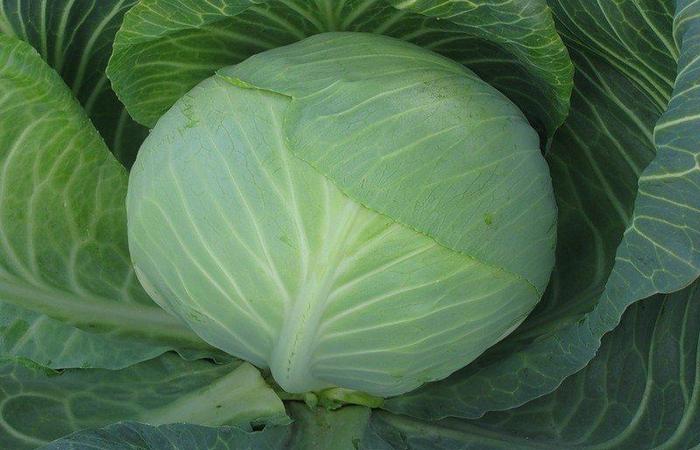

Usually late varieties of cabbage are used both for storage and for fermentation. But there is a variety that is not recommended for fermenting for the winter, because immediately after harvesting it has too hard leaves. But it is stored wonderfully until late spring and even until the summer months. This cabbage Amager 611. It is interesting that after several months of storage, its taste characteristics only improve.
The reviews and photos of those who planted Amager cabbage can be found below.
Reviews of gardeners about Amager cabbage are only good. However, this is not surprising given how many years this variety has already existed, without losing its popularity at all.
Cabbage Amager, the description of the variety of which will now be considered, first appeared in the seed catalogs of the Soviet Union in the 40s of the last century. It is still in demand now. Amager is grown throughout the territory of the former USSR, which means that this cabbage has earned the trust and love of farmers. Moreover, seeds are purchased by large farms focused on the industrial production of cabbage, and the owners of small household plots.
The Amager cabbage variety has been successfully cultivated by many gardeners for decades. Unpretentious late cabbage will delight you with good yields, subject to the rules of cultivation, and prevention of diseases.
Disease prevention
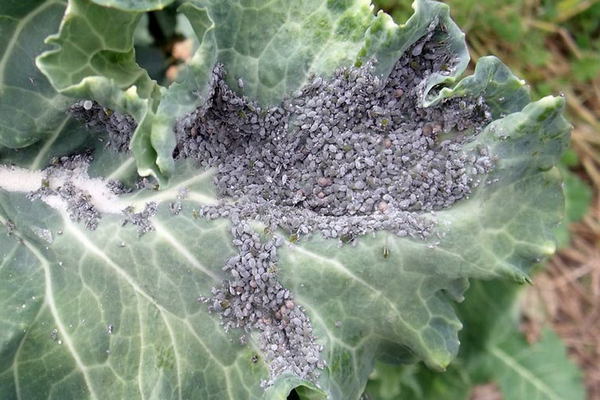

The Amager variety is susceptible to various diseases. Among the dangerous ones is fusarium wilting, which can occur immediately after planting seedlings on the ridges. There is also a weak resistance to bacteriosis, during storage - to necrosis.
The main diseases of the Amager variety, prevention and treatment
| Disease | Symptoms | Treatment | Prophylaxis |
| Fusarium wilting | Yellowing of leaf blades, loss of elasticity. In the lower leaves, tissue chlorosis is observed between the veins. The plant withers, the leaves fall off, only the stump remains. Symptoms are similar to those of vascular or keel bacteriosis. | Spraying plants with preparations Immunocytofit, Agat-25. Removal of damaged plants from the ridge and burning. Disinfection of soil after removing bushes. | Compliance with crop rotation, rules of agricultural technology. Obligatory disinfection of seeds, soil on ridges, soil for seedlings. Spraying plantings with a solution of Immunocytophyte, Fitosporin, Agat-25. |
| Vascular bacteriosis | Yellowing of the leaf blade, blackening of the veins and the formation of a black mesh (black rot). Dying off of tissues, wilting and death of plants. Black rings are visible on the cut of the stem. | Treatment of cabbage bushes with Fitolavin-300. Destruction of diseased plants. Spraying cabbage with Planriz, Binoram formulations (according to the instructions). | Pre-soaking of seed material before sowing in a solution of Agat-25, Fitolavin. Compliance with the alternation of planting crops on the site. Control of pests that spread the infection through cabbage plantings. |
| Pinpoint necrosis (affects cabbage heads during storage) | The infection infects plants in the field, detects foci during storage.Grayish or black dots appear on the leaves, merging into spots. The head of cabbage loses its presentation, taste deteriorates. Not suitable for forks recycling. | Heads of cabbage damaged by infection are removed from storage. Not used for food. | Regulation of nitrogen fertilizer doses during feeding. Spraying plantings with solutions of trace elements to increase immunity. Compliance with the irrigation regime. Obligatory inspection of heads of cabbage during storage in basements. Ensuring optimal storage temperature. Compliance with the alternation of planting crops in the garden. |
The Amager variety will not bring hassle when growing, if you follow the recommendations of agronomists. Full care with fertilization according to the norms, moderate regular watering, loosening - all this will allow you to get a high yield and save it until spring.
Treatment of plantings on ridges with compositions according to folk recipes will help to get rid of pests:
- tobacco broth;
- ash infusion;
- dry mixture of black pepper, mustard powder.
Marigolds, dill, calendula, and other plants with a pungent odor that repel insects are sown near cabbage. Chemicals are used with a large number of pests, strictly observing the processing standards.
Growing problems
Amager cabbage is quite unpretentious in cultivation. But, to avoid possible problems, it is enough to follow some recommendations:
- plant a variety with seedlings without diving;
- monitor the constant moisture of the soil;
- provide good lighting;
- carry out preventive treatments of the plant, preventing the development of diseases;
- avoid freezing and damage.
Diseases and pests
| Diseases | |||
| Name | Signs | Prevention measures | Fight |
| Fusarium wilting | The leaves turn yellow, become flabby and fall off. |
| According to instructions:
|
| Vascular bacteriosis | Leaves turn yellow, become parchment, growth stops. | Spraying with a solution of brilliant green at the rate of 10-20 drops per bucket of water. | |
| Gray rot | A fluffy coating of gray. |
| Destruction of damaged crops. |
| Pinpoint necrosis | Small black spots. |
| |
| Pests | |||
| Caterpillars | The appearance of yellow dots and holes on the leaves, twisting. | Destruction of butterflies. | Spraying with chemicals. |
| Aphids, whiteflies | Destruction of anthills. | ||
Summary varietal characteristics
| Variety or hybrid | grade |
| Ripening period | late |
| Kochan | round-flat, dense |
| Stump | small |
| Disease resistance | prone to fusarium wilt, vascular bacteriosis |
| Fruit weight, g | 2400-4000 |
| Growing areas | from the southern regions of the Russian Federation to the Urals, as well as Ukraine, Moldova, Kazakhstan. |
| Disembarkation scheme | 60-70cm x 60cm |
| From germination to ripeness | 150-175 days |
| Seeding depth | 1.5-2 cm |
| Seedling age | 40 days |
| Soil temperature for planting seeds / seedlings | +4/+12 |
| Benefits | stored for a long time, transportable, gives a stable high yield |
| disadvantages | picky about soil fertility, hygrophilous, does not tolerate high temperatures, not suitable for fermentation in the first 2 months after harvesting |
Growing and care
Watering
The bushes are watered with water at room temperature, regularly and abundantly. Water is brought in at the root in the evenings. Young plants need watering in small portions and often, adults - less often and more abundantly. 2 months before ripening, they begin to reduce watering, and in 10-20 days they stop completely, otherwise the heads of cabbage will be worse stored.
Top dressing
Fertilize monthly. Weak nitrogen solutions are introduced under the seedlings, a little humus and wood ash are placed in the holes during planting, but so that the roots do not touch them directly. The first time in the garden is fed 10 days after transplantation.A complex mineral fertilizer or organic solution is introduced, for example, manure or chicken droppings.
Before the appearance of ovaries, nitrogen should prevail in dressings, and with the development of forks - potassium and phosphorus.
Harvesting
Heads of cabbage are cut with a sharp knife or hatchet in dry weather. They are able to withstand frosts down to -3, so you can start harvesting with the first frost.
Storage
Cabbage is kept in a cold room with a temperature of about +1, dry and dark. If light penetrates it, the heads of cabbage can sprout.
Nuances of seed preparation
Amager cabbage seeds
Cabbage of this variety is grown in seedlings or sown in the ground.
To increase immunity to diseases, seeds are treated with Fitosporin solution. Soak for 8-10 hours. The same solution disinfects the soil for sowing. Such processing is carried out a day before sowing and reduces the risk of various diseases.
Amager cabbage seeds are planted in special seedling boxes. The planting depth of the seed is 1-2 cm. If the seeds are deepened, the period of their germination will increase significantly.
For seeds, use a purchased soil mixture or prepare the substrate yourself. This requires:
- garden land;
- peat;
- sand.
After planting, the seedling boxes are covered with foil and removed to a dark, warm place until the first shoots appear. Seeds germinate together for 5-7 days.
Temperature
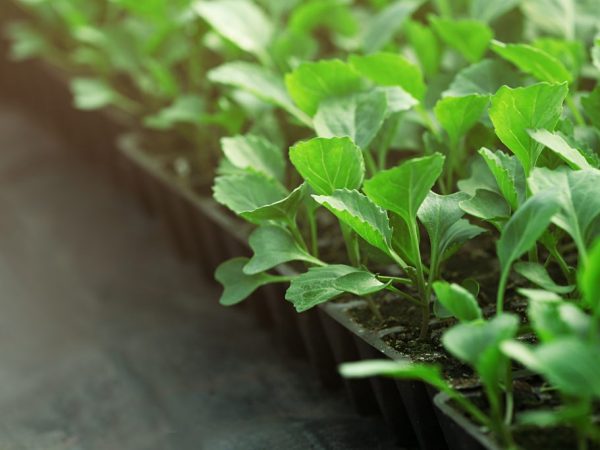

Maintain the optimum temperature for seedlings
Seedlings of white cabbage are grown at a temperature of 15-18 ° C.
Disembarkation scheme
Grown plants are planted in a permanent place in May. The garden bed is planned in advance, since when transplanting, the cabbage bush occupies only 2-3% of the total area. In the process of growing and forming heads of cabbage, it already needs about 70-80%. The sprouts are planted at a distance of 40-50 cm from each other. Every centimeter plays an important role in the development of culture.
Fertilizers
Humus and wood ash are preliminarily introduced into the beds. This provides the young plant with organic and mineral components.
Seeds of cabbage variety Amager Cabbage of this variety is grown in seedlings or sown in the ground.
Seedlings are planted in the last days of February or in March. This requires a properly prepared soil. The best option is special mixtures made from equal parts of turf, sand and peat. It is not recommended to use humus, as the black rot virus may remain in it.
The key to a good harvest is proper seed preparation. First, they are placed in water at a temperature of 50 ° C for about 15 minutes. After that, they keep it in cool water for about a minute.
Then they put it in a solution of trace elements for half a day, which is sold in any gardening store. Then the seeds are washed. For this, running water is used. The seeds prepared in this way are kept in the refrigerator for 24 hours.
Healthy head of cabbage
Before planting, the prepared soil must be watered with potassium permanganate. Sowing is done in rows, leaving a distance of 1 cm and 3 cm between the grooves between the holes. Planting depth 1.5-2 cm.
Seedlings need to be fed. When 2 real leaves appear, this can be done for the first time. To do this, add half a teaspoon of microelements with complex fertilizers to a liter of water. It is necessary to spray the seedlings with this solution.
The second time the plants are fed with a tablespoon of urea diluted in 10 liters of water and the same amount of potassium sulfate. It is necessary to water the plants with this composition. Do this before hardening them.
The beginning of April is suitable for sowing Amager cabbage seeds directly into open ground in the south, and the third decade of this month - in central Russia. In this case, the following rules must be observed: It is necessary to plant in damp ground.
- Planting depth should be 1.5-2 cm.
- For 10 square meters, you need to spend 2.5-3 g of seeds.
- A distance of 65-70 cm is maintained between the rows.
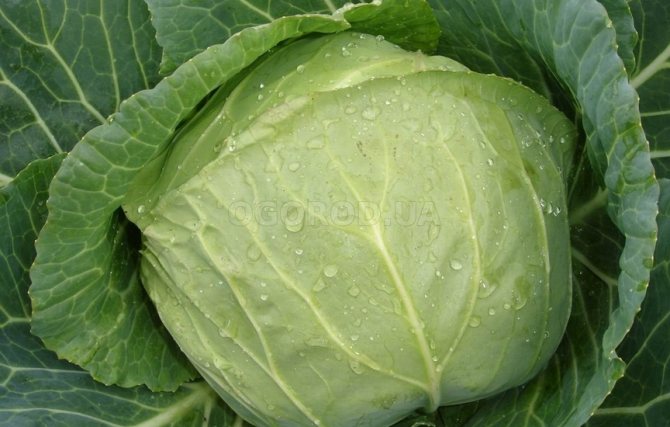

Compliance with all the nuances of preparing and planting seeds will help you get a good harvest.
Expert opinion
Yulia Yurievna
I have a large garden and vegetable garden, several greenhouses. I love modern methods of plant cultivation and soil mulching, I share my experience.
Ask a Question
Amager cabbage is highly susceptible to fungal diseases during the period of growing seedlings. For this reason, care must be taken in handling and disinfection. Well-rotted humus is an important component of the substrate, which makes it friable and nutritious.
To protect the plant from the black leg, it is important, after mixing all the components, including humus, to pour boiling water over the substrate. If the volumes of cultivated cabbage are small, we recommend roasting the soil in the oven. But, after that, it is impossible to plant seeds right away, you need to let the ground stand for 1-1.5 weeks, so that a useful microflora develops.
Thermal disinfection is the most laborious, but at the same time reliable, because it destroys not only spores and bacteria, but also the larvae of harmful insects. Another disinfection option would be watering with a solution of manganese, boron, Fitosporin, Magnicur. The listed funds can be used for prophylactic treatment of seedlings.
We would like to note that some companies sell Amager cabbage seeds already processed. These seeds can be blue or bright green in color due to the preparations in which they were soaked. In this case, no additional processing is needed.
We recommend keeping the distance between the seeds at least 2.5 cm. The thickening of the plantings is one of the factors that reduces the immunity of plants and provokes the development of the fungus. In addition, the seedlings begin to stretch, become thin and brittle.
The planting depth can be reduced to 1 cm. Especially if the soil is not too light. After Amager cabbage seeds are laid out in grooves, they must be sprinkled with light soil, watered from a diffuser, covered with foil and placed in a warm place for germination.
It is best to also carry out the specified first watering with a solution of some fungicidal agent.
A pick can also be carried out in the presence of 2-3 real leaves. But, in this case, some skill and experience is required. Plants are small and fragile. Also, when the cabbage is in a new container, you cannot fill the growth point, otherwise the seedling will die.
It is best to lower the plant over the cotyledonous leaves. After the end of the pick, you need to water the seedlings with a fungicidal solution again. Fertilizing within the next 2 weeks is not worth it.
Amager cabbage is a fairly cold-resistant crop. But, even it needs to be hardened for a week before planting in open ground. For this, containers with seedlings are taken out into the garden. First, by 1.5-2 hours, and then, the duration of the walks is gradually increased.
We recommend that you first pour the holes that are prepared in the open field with a manganese solution. In the future, it is important to protect the crop from the cabbage fly. When the cherries are about to bloom, we recommend spraying the cabbage beds with BI-58.
We suggest you familiarize yourself with: Cauliflower for the winter: how to freeze it in the freezer and how to cook it later?
Watering rules
Cabbage of the Amager 611 variety, popular among gardeners, needs correct and timely implementation of irrigation measures at all stages of the growing season:
- To protect the leaves of a vegetable crop from sunburn, watering should be carried out exclusively in the early morning or after sunset. More economical is watering with water in the holes, which are located near the plants.
- The frequency of watering white cabbage depends on the soil characteristics in the region of cultivation, as well as the weather factors of a particular growing season.For irrigation, you should use water heated during the day by the sun.Using too cold water often causes a delay in the growth and development of a vegetable crop, and can also provoke diseases of the root system.
- As the harvest time approaches, the number and frequency of watering should be gradually reduced to minimize the risk of cracking of almost fully ripe heads of cabbage. About a month before harvesting a crop intended for long-term storage throughout the winter period, irrigation activities should be stopped completely.
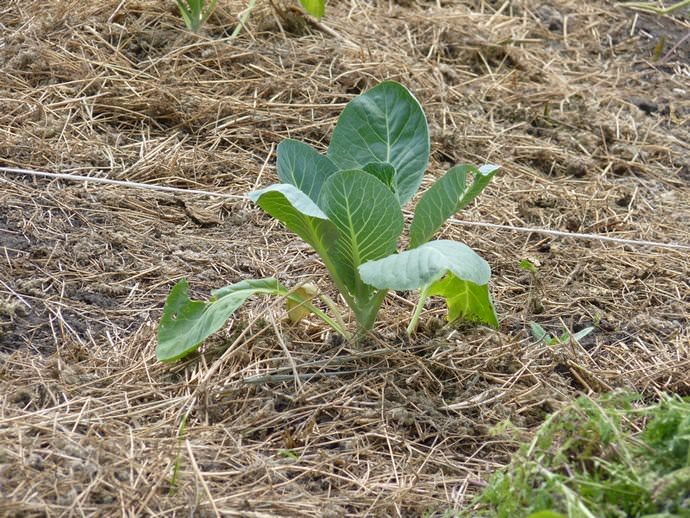

How to grow Amager cabbage
There are two ways to grow this cabbage:
- using seedlings;
- direct sowing into the ground.
Amager cabbage
It should be sown on the beds at the end of April. In cold areas, it is permissible to grow only in seedlings. Young plants are planted in a permanent place at a distance of 50-70 cm from each other.
Advice. When planting, the cabbage stem is best deepened before the leaves begin to grow. This will form a strong root system.
The variety requires frequent watering, hilling and feeding.
Some gardeners have been growing the Amager variety for generations, while they have no complaints. There is a good keeping quality and the fact that the forks do not crack even during prolonged rains. The presence of bitterness during the first two months after harvesting from the garden is called a disadvantage. It is advised to treat young plants with anti-rot preparations on time.
Amager is an excellent late variety for hobbyists and farmers alike. Due to its positive characteristics, it has been holding a leading position among the variety of cabbage for about 100 years.
How to distinguish from others?
Among many other late varieties, Amager stands out for some, inherent only to her, differences. Let's see how you can distinguish it from others:
- First of all, we inspect the head of cabbage - its shape should be round, but slightly flattened, large in size.


We look at the color of the leaves - they should be gray - green (bluish - green) in color with an obligatory waxy bloom (other varieties do not have such a bloom).
Cabbage care
Caring for cabbage in the exhaust gas consists of the following measures:
- Loosening the soil.
- Hilling.
- Watering.
- Fertilizers of culture.


Watering
Once the seedlings have been moved to a permanent location, they need to be watered every 2 days for 14 days. Also, it is important to water the cabbage in July-August. At this time, heads of cabbage are tied and the plant needs a lot of energy.
You need to water the vegetable with warm water (cold water can cause a vegetation delay), in the morning or in the evening, when the sun is hidden behind the horizon (so that no burns appear). You should try to pour water at the root, without getting on the leaves. It is for this reason that the drip irrigation system is considered the most preferable.
Watering is stopped about 3 weeks before harvest. This will reduce the risk of possible head cracking and increase the keeping quality of the “heads”.
Weeding and loosening
The site must be kept clean. Weed grass strongly inhibits the development of agricultural crops, drawing nutrients and water from the soil. To get rid of weeds, it is necessary to periodically weed.
Read also: Pickled assorted vegetables for the winter
Also, you need to loosen the soil. After frequent watering, the soil becomes compacted, and the cabbage root system begins to suffer from a lack of oxygen. Loosening solves this problem.
Fertilizer
To get really large heads (about 4 kg), you need to fertilize the plant. Immediately after moving the seedlings into the ground, it is advisable to water the sprouts with a solution of 10 liters of water, 10 g of urea and 20 g of superphosphate.
It is also worth noting that different dressings have different effects on the crop. For example, nitrogen-containing fertilizers are ideal for gaining leaf mass, and phosphorus-potassium fertilizers contribute to the formation of a head of cabbage.Therefore, during the head formation phase (after July), nitrogen-containing fertilizers cannot be used.
Harvesting
After the first frosts hit (the night temperature drops to -2 degrees Celsius), you can start harvesting. It is impossible to overexpose the heads of cabbage during this period, since if they freeze, then their keeping quality indicators will significantly deteriorate.
It is best to store the crop in a room where the air temperature is between -1 ... + 1 C.
Care
Those who planted crucifers know that they are demanding on light. Due to the lack of light, the seedlings stretch out, which affects the ability to form forks, however, in the first days after transplanting seedlings into open ground, the beds are provided with a little shading in the afternoon. This protects the plant from sunburn.
Watering
The culture is watered several times a week. The land should be wet, but no stagnant water. Waterlogging threatens the heads of cabbage cracking. Such forks are no longer suitable for storage.
Top dressing
Timely feeding are also important for planting:
- To improve growth, plants are fed a week after planting in a permanent place. To do this, manure is soaked in water in advance at the rate of 1 kg per 3 liters of liquid. After 2 weeks, fermentation is stopped and the fertilizer is ready for use. It is not used in its pure form, but diluted with 1 liter of the mixture per 10 liters of water.
- When the fork is formed, the plant is fed a second time. For tying strong heads of cabbage, he needs potassium and phosphorus.
- The last top dressing, if necessary, is carried out 2 weeks before harvest. It is best to use an herbal infusion. To make it, weeds are finely cut and soaked in water for 12-14 days. After this mixture, in a diluted form, the plants are watered.
Advantages and disadvantages
The main advantage of the variety can be considered its ability to maintain its taste for a long time. You can store this cabbage until April. The head of cabbage can crack only with excessive watering, but other factors will not lead to this.
Amager copes well with cold and frosty conditions.
Poor growth in high temperature conditions is considered a disadvantage. It is possible to save cabbage in hot conditions only if an intensive irrigation regime is observed to maintain soil moisture at the level required for the variety. Amager does not cope with the attacks of various pests in the best way, crops must often be carefully and carefully examined and not rushed to use aggressive means to fight.
Fertilization chart
Fertilization is necessary for the plant to develop properly. After planting in the ground, the first top dressing is carried out after 15 days with a liquid solution of mineral substances. In a bucket of water, they are diluted with 20 g of potassium fertilizer and superphosphate, 10 g of urea. Such a solution contributes to the enhanced growth of the culture.
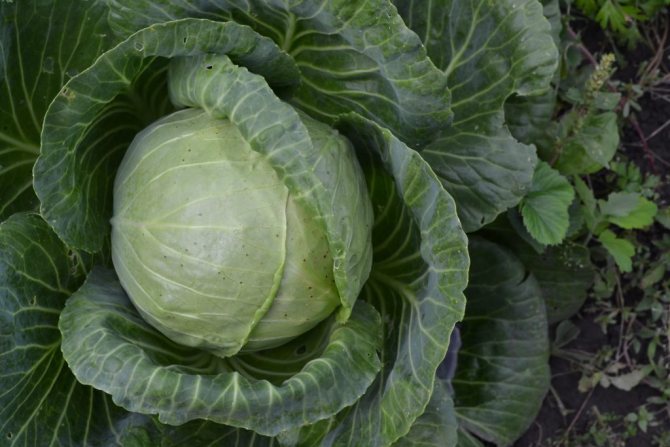

A very good remedy is mullein infusion. It is prepared from the calculation: a bucket of a mullein for ten buckets of water. They insist for two days. They bring in half a liter for each bush.
The second feeding of cabbage is carried out two weeks after the first. In each hole - one liter. You can reuse mullein or make a 1:25 infusion of chicken droppings.
Cabbage leaves are sprinkled with wood ash for pest control, in the form of an infusion, poured under the root. Mineral fertilizers affect the formation of large heads and improve the taste of cabbage.
Dusting wood ash is used for pest control
Fertilizers are applied for the third time after 10 days according to the same scheme. Two weeks before harvest, cabbage is fed a fourth time to improve storage properties.
Fertilize after watering or rain. Care must be taken to ensure that fertilizer solutions do not fall on the leaves.
Similar varieties
- "Mara" - is an extremely late variety, since the growing season takes 165 days. The average fruit weight is 4 kg. High palatability, long-term storage.
- "Snow White" - ripening period - 160 days, head weight - 4 kg.Perfect for fermentation and long-term storage.
- "Valentina" - it has a long ripening period, up to 180 days. Head weight - 4 kg, shelf life - 8 months.
Cultivation of Amager cabbage, subject to simple rules of agricultural technology, does not require large expenses. The result of constant and timely care will be a rich harvest that will be stored until next summer.
GLOBE MASTER F1 / GLOBE MASTER F1
All the existing variety of different types of cabbage is divided into 12 types, namely: White cabbage - Brassica oleracea convar. capitata (L.) Alef. var. capitata L. f. alba DC - have a closed white-headed apical bud, growing into a head of cabbage and lateral buds that are inactive until the formation of a head of cabbage is complete. Biennial vegetable plant. In the first year, a head (head) is formed, in the second year after overwintering, the plants form flower stalks. Red cabbage - Brassica oleracea canvar. capitata (L.) Alef. var. capitata L. f. rubra (L.) Thell. As well as white cabbage, it forms a head (roach) only with an intense red-purple color. It is less productive, has a coarse roach consistency and is better stored. Savoy cabbage - Brassica oleracea convar. capitata (L.) Alef. var. sabauda L. It differs from white-headed cabbage by bubbly leaves, in which the parenchyma grows faster than the conductive tissues of the vascular bundles. Forms large loose heads of cabbage. Capable of accumulating 1.5 times more protein than white-headed cabbage. Brussels sprouts - Brassica oleracea convar. oleracea var. gemmifera DC. It has an active and open apical kidney and closed lateral kidneys. On a stump with a height of 50-100 cm in the axils of leaves it forms up to 30-40 loose heads of cabbage, which contain 2 times more protein and 4 times more vitamin C than heads of white-headed cabbage. Cauliflower - Brassica oleracea convar. botrytis (L.) Alef. var. botrytis L. Early maturing and very nutritious plant. It has an active and open apical kidney, which ends its development with the formation of a large head, which is a productive organ. The cauliflower head consists of a large number of shortened flower stalks, which are high in protein and carbohydrates and low in fiber. Broccoli - Brassica oleracea var. cymosa Duch. They are called asparagus cabbage, in which flower shoots are used for food, forming a loose crumbling head. Kohlrab cabbage - Brassica oleracea L. convar. acefala (DC) Alef. gongilodes L. Plants form a shortened and heavily thickened stump - a stalk that is boiled for food. Differs in a high content of vitamin C. Collard greens - Brassica subspontanea Lizg. Plants with flat and corrugated leaves. Ornamental cabbage - Brassica oleracea L. convar. acefala DC. A variety of ornamental cabbage combines two forms: flat-leaved and curly-leaved. The flat-leaved form has many different forms. It includes various varieties of forage collard greens, a group of varieties of forage cereal cabbage with a thick (up to 10 cm) and long stem. The curly-leaved form includes varieties in which the leaf blade has multiple corrugated or jagged edges. Chinese cabbage - Brassica chinensis L. The plant, in comparison with Mediterranean species, is more early maturing in conditions of long days and moderate temperatures. Many people still confuse it with Peking cabbage. Peking cabbage - Brassica pekinensis (Lour.) Rupr. Annual, cold-resistant and low-light tolerant plant. It belongs to plants of intensive growth, but reacts very much to an increase in the length of the day, high and low temperatures, at which it quickly passes into the reproductive stage of development. Due to the delicate texture of the leaves, it is strongly affected by diseases and damaged by pests. Japanese cabbage - Brassica japonica Sieb. Origin - Japan. Ultra-ripe, productive, unpretentious salad vegetable crop for open and closed ground.
Purpose of use
One can definitely say about Amager cabbage - the longer it is stored, the better its taste.... The bitterness that is present in the leaves immediately after harvesting disappears after a month and a half, leaving only a pure pleasant taste and the juiciness increases. Cabbage just has to "lie down" - to ripen.Naturally, it is actively used for preparing fresh dishes, since it is stored perfectly until the end of spring.
ATTENTION: As you know, it is the late varieties that are ideal for pickling and pickling, because by the middle of autumn (by the time of harvest) they accumulate the largest amount of nutrients and vitamins.
- Pickling - in this version of the blanks, the preservative is lactic acid, which is obtained naturally as a fermentation product. And the fermentation process itself occurs thanks to the sugars that are in cabbage, as a result, we feel only the pure taste of the product - this is very useful. Sour cabbage is best done in small oak barrels or in enamel buckets. It should be stored at a temperature of 4 - 5 degrees Celsius.
- Salting - thanks to the addition of salt, the process of reproduction of unnecessary bacteria is blocked. Salted cabbage is also incredibly useful, especially during various epidemics (flu or SARS), it strengthens the immune system very well.
What are the best varieties of cabbage for storing, growing and cooking, read here.
Cooking use
The taste of Amager heads of cabbage is delicate, has a pronounced cabbage aroma, however, its leaves are very tough. The bitterness present in the forks disappears after 30-45 days of storage, the head of cabbage gains juiciness and sweetness, becomes softer. After this ripening, cabbage is used:
- in salads;
- for preparing first and second courses;
- fermentation.
Important!
Late variety of white cabbage Amager is suitable only for fermentation in winter or spring. During the ripening of cabbage, a large amount of sugars accumulates, thanks to which the fermentation process takes place. Such cabbage is very useful as it contains many vitamins and minerals.

